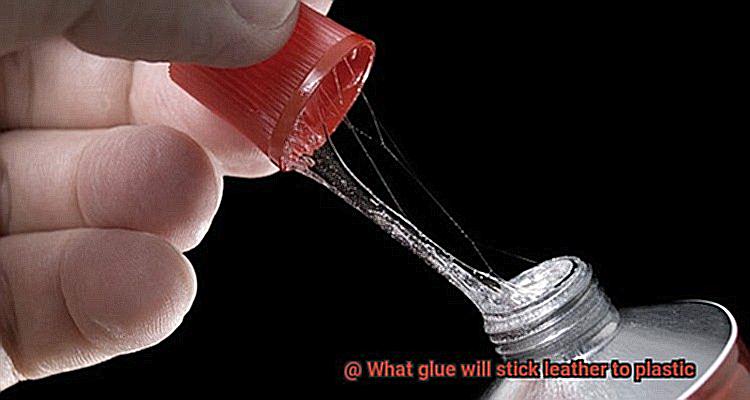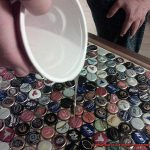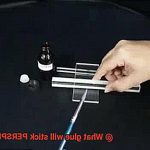Joining leather and plastic may seem like an impossible task, but fear not. We’re here to unravel the mystery of finding the perfect glue. Whether you’re a crafting enthusiast, a repair wizard, or a professional in need of a reliable solution, choosing the right adhesive is crucial. In this blog post, we’ll dive into the world of glues and discover the best one for sticking leather to plastic.
The challenge lies in finding an adhesive that not only bonds these two materials together but also withstands everyday wear and tear. Leather and plastic have their own unique properties, making their adhesion a tricky puzzle to solve. Luckily, there are specialized glues designed specifically for this purpose, ensuring a strong and long-lasting bond.
Get ready to embark on an adhesive journey with us as we uncover the secrets behind successfully uniting leather and plastic. We’ll explore different types of glue, their standout features, and important factors to consider when making your choice. Whether you’re working with leatherette, PVC, ABS, or any other type of plastic – we’ve got your back.
Stay tuned for our comprehensive guide on the best adhesives for this specific bonding challenge. From epoxy and cyanoacrylate to dedicated leather and plastic bonding agents – we’ll evaluate their strengths, weaknesses, and application techniques. Armed with our expert insights, you’ll be equipped with all the knowledge needed to confidently tackle any leather-to-plastic project.
So if you’ve been tirelessly searching for the ultimate solution to your leather-to-plastic gluing needs, look no further. Get ready to unlock the secrets of adhesion that will seamlessly bring these two materials together – ensuring your creations stand the test of time. Let’s get started.
What is Leather and Plastic?
Contents
Leather and plastic may seem like an unlikely pair, but there are many instances where you might need to stick them together. Whether you’re working on a DIY project or repairing a leather item with plastic components, finding the right glue is essential for a strong and durable bond. In this article, we will delve into the world of leather and plastic, uncovering their unique qualities, exploring their surface differences, and recommending the best glues to use in various situations.
Understanding Leather:
Leather, a versatile material derived from animal hides, is highly valued for its natural texture, strength, and aesthetic appeal. From full-grain to bonded leather, each type offers distinct qualities and uses. With its porous surface that can breathe and absorb moisture, leather exudes both beauty and functionality.
Unveiling Plastic:
Plastic, a synthetic or semi-synthetic material made from polymers, is known for its remarkable versatility. It can be molded into countless shapes and forms. Polyethylene (PE), polypropylene (PP), polyvinyl chloride (PVC), and polycarbonate (PC) are just a few examples of the different types of plastics available. Plastic’s smooth surface is often non-porous, allowing it to resist moisture.
Surface Differences:
The contrasting surface characteristics of leather and plastic play a significant role when bonding them together. While leather’s porous surface readily absorbs moisture, plastic’s smooth surface poses a challenge. The right adhesive must bridge this gap to create a reliable bond between these two materials.
Recommended Glues:
- Epoxy Adhesive: Renowned for its exceptional bonding strength and versatility, epoxy adhesive is a top choice for adhering leather to plastic. This two-part adhesive consists of a resin and hardener that are mixed according to the manufacturer’s instructions. Epoxy creates an unyielding bond capable of withstanding heavy stress and strain.
- Cyanoacrylate Adhesive (Super Glue): With its fast-drying properties, super glue forms an instant bond on various materials, including leather and plastic. Applying it sparingly and firmly holding the glued surfaces together for a few minutes ensures a proper bond.
- Contact Adhesive: Offering flexibility and temperature resistance without compromising bond strength, contact adhesives create an instant bond when two treated surfaces come into contact. They are ideal for leather and plastic applications requiring durability.
- Polyurethane Adhesive: For specialized projects demanding flexibility and resilience, polyurethane adhesive is an excellent choice. This adhesive forms a strong and durable bond that can withstand extreme temperatures and environmental conditions.
Epoxy Adhesive
In the quest for a trustworthy adhesive to unite leather and plastic, look no further than the mighty epoxy adhesive. Renowned for its unwavering strength and remarkable durability, epoxy adhesive offers the ideal solution for creating an unyielding and enduring bond between these two materials. This tutorial will serve as your guiding light through the intricate process of working with epoxy adhesive, from meticulous surface preparation to masterful application techniques. Let’s embark on this journey together.
Step 1: Clean and Prepare Surfaces
The first step towards achieving an impeccable bond is to ensure that both the leather and plastic surfaces are pristine. Bid farewell to dirt, grease, and moisture by meticulously wiping them down with a suitable cleaner or solvent. Allow them to luxuriate in complete dryness before proceeding.
Step 2: Harmonize the Epoxy Components
Epoxy adhesive is a symphony of two components—the resin and the hardener—whose union creates an extraordinary adhesive concoction. In a clean vessel, diligently blend equal parts of the resin and hardener, harmonizing them with precision as guided by the manufacturer’s instructions.
Step 3: Brush on Brilliance
With an artist’s touch, delicately apply an even layer of the mixed epoxy adhesive onto both the leather and plastic surfaces. Bestow upon them just enough adhesive to create a thin, uniform coating that dances gracefully without any excessive dripping or wayward running.
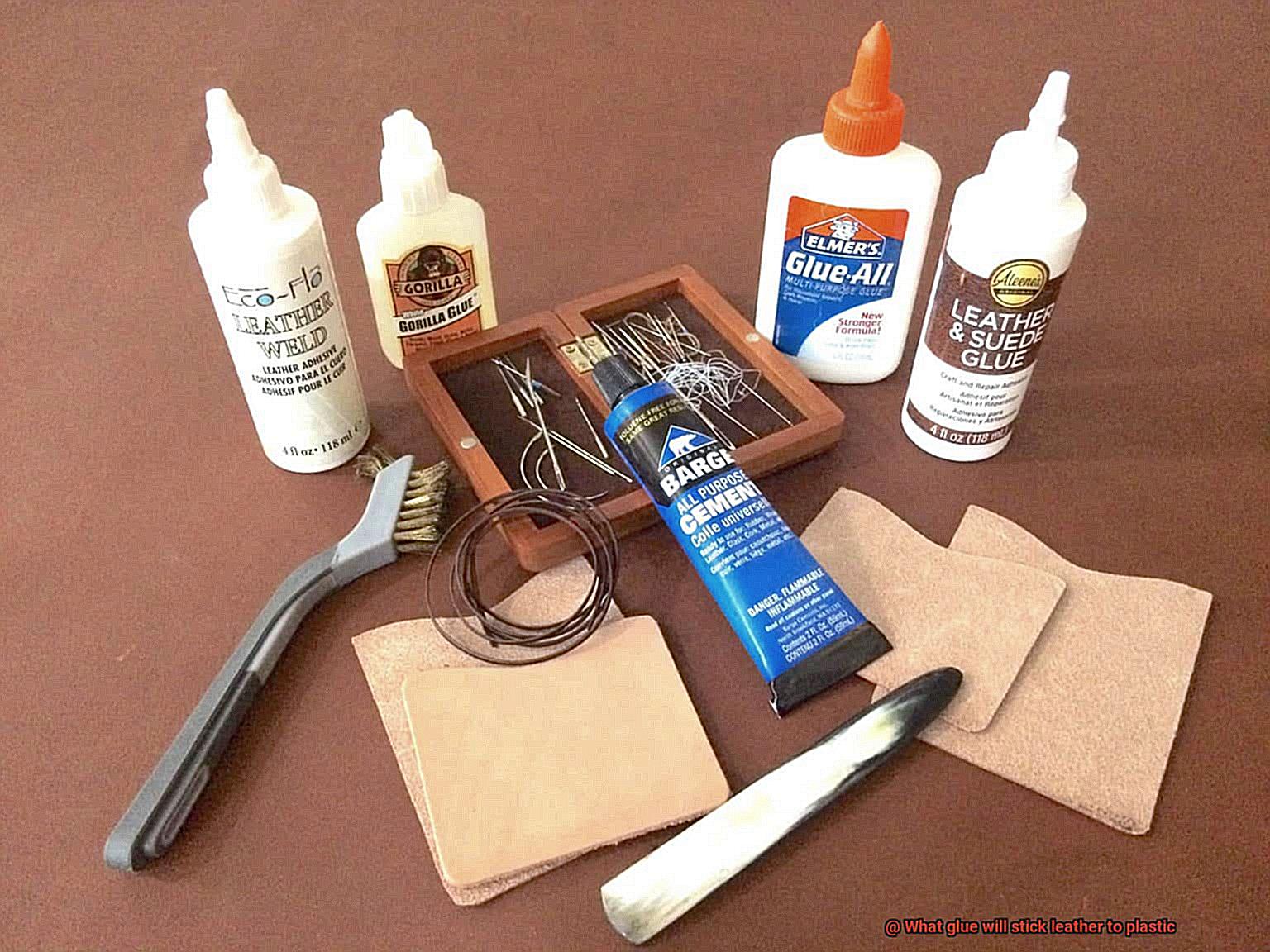
Step 4: Press and Embrace
Unite the leather and plastic surfaces with a firm press, ensuring their perfect alignment. Hold them tenderly in your embrace until the glue sets. The duration may vary depending on the product, entailing a few minutes or perhaps several hours.
Step 5: Secure Strength
To fortify the bond, it is advisable to employ clamps or weights while the epoxy adhesive cures. These stalwart defenders will maintain unwavering pressure and prevent any untoward movements during the curing process.
Step 6: Embrace the Passage of Time
Epoxy adhesive, like a fine wine, matures with time. Allow it to bask in this transformative period, as it gradually reaches its zenith after 24 hours of curing. However, it is crucial to heed the manufacturer’s instructions regarding specific curing times and recommendations.
Cyanoacrylate Adhesive (Super Glue)
Cyanoacrylate adhesive, also known as super glue, is a powerful and efficient adhesive that is widely used for bonding leather to plastic surfaces. Its quick-drying time and exceptional strength make it a go-to choice for DIY enthusiasts and professionals alike. With the right materials and proper application, this adhesive creates a bond that can withstand the test of time.
To begin, gather the necessary materials: a high-quality cyanoacrylate adhesive designed for bonding plastics, mild detergent or rubbing alcohol, clean cloths or paper towels, fine-grit sandpaper, and a sharp object like a knife or needle.
Before applying the glue, it’s crucial to prepare the surfaces. Clean both the leather and plastic thoroughly using mild detergent or rubbing alcohol to remove any dirt, dust, or grease that could hinder the bonding process. Allow the surfaces to dry completely before moving on.
Next, roughen up the plastic surface slightly to enhance adhesion. This can be done by gently sanding it with fine-grit sandpaper or creating small scratches with a sharp object. This step increases the surface area for the adhesive to grip onto, resulting in a stronger bond.
Now it’s time to apply the super glue. Remember, less is more with this powerful adhesive. Use a precision applicator or toothpick to apply a small amount of glue to one of the surfaces – either the leather or plastic. A thin and even layer is all you need for a secure bond.
Once applied, quickly press the leather and plastic together, aligning them perfectly. Avoid repositioning them once they are in contact because super glue sets within seconds. Hold the surfaces firmly together for a few moments to allow the adhesive to bond fully.
Congratulations. You’ve successfully bonded leather to plastic using cyanoacrylate adhesive. Now, let the adhesive cure completely, which usually takes around 24 hours. During this time, avoid subjecting the bonded area to any stress or excessive moisture.
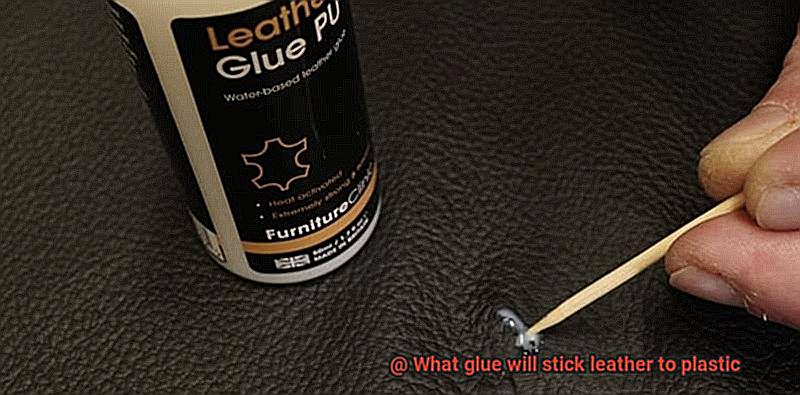
Remember to prioritize safety when working with super glue. Work in a well-ventilated area and wear protective gloves to avoid skin contact. If accidental skin contact occurs, gently wash the affected area with warm water and soap.
Contact Adhesives
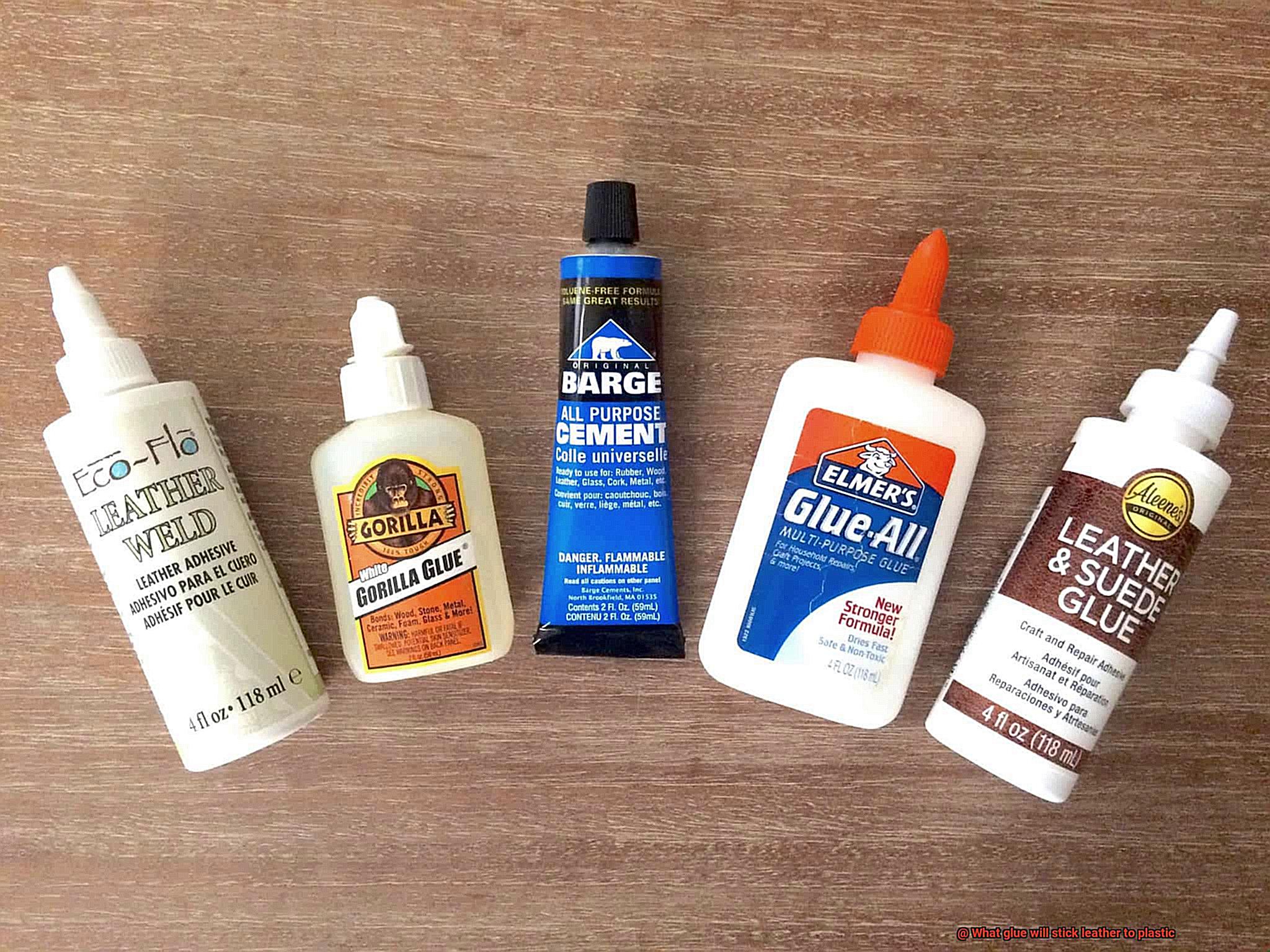
Contact adhesives are powerful glues that are specifically designed to create a strong and durable bond between different materials, such as leather and plastic. They are the go-to solution for anyone looking to take their DIY skills to the next level and successfully bond these two materials together.
There are two main types of contact adhesives that work wonders when it comes to bonding leather and plastic. The first option is neoprene-based adhesive, which is made from a synthetic rubber called neoprene. This adhesive offers excellent adhesion and flexibility, making it perfect for projects involving leather and plastic. To use this adhesive, simply apply it to both the leather and plastic surfaces, allow it to dry until it becomes tacky, and then firmly press the two surfaces together. The result is a strong bond that can withstand heat, water, and chemicals.
The second option is polyurethane-based adhesive. This adhesive is known for its exceptional strength and flexibility, making it an ideal choice for bonding materials with different properties, like leather and plastic. To use this adhesive, apply it to both surfaces, let it dry until tacky, and then press the two surfaces together. The end result is a bond that can withstand anything life throws its way.
However, before embarking on your bonding adventure, proper surface preparation is crucial. Start by cleaning both the leather and plastic surfaces to remove any dirt, dust, or grease that could hinder the bonding process. You can use mild detergent or rubbing alcohol for this step. Once clean, make sure to let the surfaces dry completely before applying the adhesive.
For enhanced adhesion, consider roughening up the plastic surface slightly. You can achieve this by using fine-grit sandpaper or creating small scratches with a sharp object like a knife or needle. This will provide the adhesive with more surface area to grip onto, resulting in a stronger bond between the leather and plastic.
When applying the adhesive, remember that less is more. Use a precision applicator or a toothpick to apply a small amount of glue to one of the surfaces – either the leather or plastic. A thin and even layer is all you need for a bond that will stand strong against anything life throws its way. Once applied, bring the two surfaces together with precision and hold them firmly for a few moments to allow the adhesive to work its magic.
After successfully bonding leather to plastic using contact adhesives, it’s important to let the adhesive cure completely, which usually takes around 24 hours. During this time, treat your creation with care and avoid any stress or excessive moisture.
Polyurethane Adhesives
Look no further. Polyurethane adhesives have emerged as the go-to solution for joining these two materials. With their exceptional bonding capabilities, flexibility, and specialized formulations, they are the perfect pair for creating a strong and durable connection. Let’s explore the advantages of polyurethane adhesives and discover why they reign supreme in bonding leather to plastic.
Advantage 1: Versatility that Packs a Punch
Polyurethane adhesives possess the remarkable ability to bond both porous and non-porous materials, making them an unrivaled choice for joining leather and plastic. By penetrating deep into the pores of the leather, they establish a secure connection with the plastic surface, creating an incredibly strong bond that stands the test of time.
Advantage 2: Flexibility that Moves with You
Leather and plastic experience varying levels of expansion and contraction due to changing environmental conditions. This is where polyurethane adhesives truly shine. They gracefully accommodate these movements without compromising their bond strength. So whether you face temperature changes or other challenges, rest assured that your leather-plastic bond will remain intact.
Advantage 3: Specialized Formulations for Optimal Results
Not all polyurethane adhesives are created equal. When it comes to bonding leather to plastic, choosing an adhesive specifically formulated for this application is crucial. These specialized polyurethane adhesives contain additives that enhance their bonding properties with leather and plastic surfaces. Look for these tailored formulations to achieve the best results.
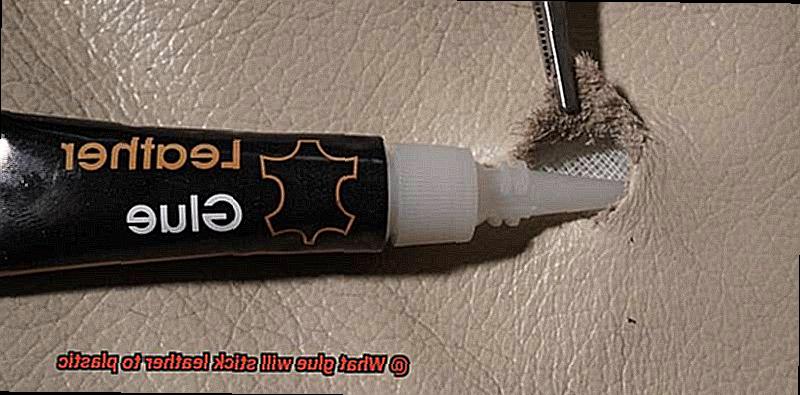
Application Tips: The Road to Success
To ensure a successful bond, proper surface preparation is key. Clean, dry surfaces free from contaminants like dust, grease, or oils are a must. Additionally, lightly roughening the surfaces with sandpaper improves the adhesive’s grip. Apply the polyurethane adhesive evenly onto both surfaces using a brush or applicator, following the manufacturer’s instructions for drying time and any additional steps. Firmly press the leather and plastic together, employing clamps or weights to hold them in place while the adhesive cures.
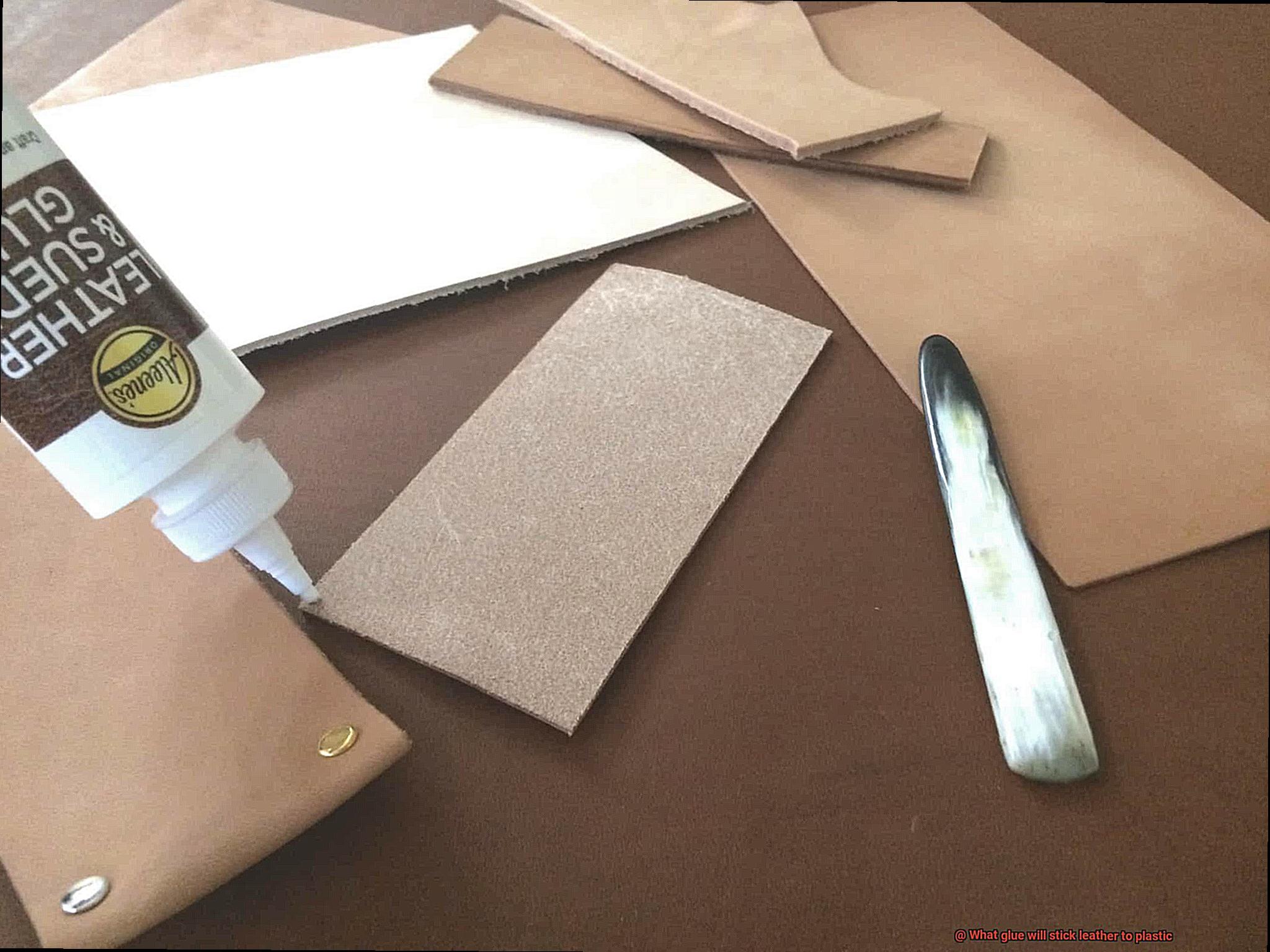
Different Types of Plastic Require Different Glues
It’s not as simple as using any old glue lying around. When it comes to sticking leather to different types of plastic, the right glue is crucial. Each type of plastic requires a specific glue to create a lasting bond. In this article, we’ll explore why different plastics require different glues and discover some of the best options for bonding leather to plastic.
Types of Glue:
When it comes to gluing leather to plastic, there are several recommended types of glue. Epoxy glue is a popular choice due to its incredible strength and durability. It forms an unbreakable bond between leather and plastic. Another option is super glue, also known as cyanoacrylate adhesive. This fast-drying glue creates an instant bond that holds strong. Contact adhesive is another excellent choice, as it creates an immediate bond when the treated surfaces come into contact.
Types of Plastic:
Plastics come in various forms, including polyethylene (PE), polypropylene (PP), polyvinyl chloride (PVC), polystyrene (PS), and acrylonitrile-butadiene-styrene (ABS). Each plastic type has unique properties that affect how well it bonds with glue. Some plastics, like PE and PP, have low surface energy, making them challenging to stick together. On the other hand, plastics like PVC, PS, and ABS have higher surface energy, making them more receptive to bonding with glue.
Adhesion Requirements:
To achieve a successful bond between leather and plastic, it’s essential to select a glue that meets the adhesion requirements of both materials. When working with low surface energy plastics like PE or PP, specialized adhesives designed for these plastics are necessary. For higher surface energy plastics like PVC or ABS, there are more options available when choosing a suitable glue.
Chemical Reactions:
Different types of plastic have unique chemical compositions, which impact their ability to bond with glue. The adhesive properties of glues vary depending on the surface they are applied to. It’s crucial to choose a glue that is compatible with both the plastic and the leather to ensure a strong and long-lasting bond.
Applications:
Knowing which glue to use for bonding leather to plastic is vital for various applications. Whether you’re repairing a leather strap on a plastic bag or attaching leather trim to a plastic surface, choosing the right glue guarantees a sturdy and enduring bond.
Applying the Glue Properly
When it comes to the art of crafting or repairing, there is no challenge quite as common as joining leather and plastic. Whether you are fashioning a stunning leather bag with plastic accents or mending a torn leather seat in your car, the secret to success lies in the proper application of glue. So, let us delve into the enchanting world of adhesives and unveil why it is absolutely crucial to get it right.
Before embarking on this adhesive adventure, it is imperative to prepare the surfaces that will be bonded. Just as you would never dream of sticking a Band-Aid on a dirty wound, you must ensure that both the leather and plastic surfaces are immaculately clean, free from any dirt, dust, or oils. A vigorous scrub using mild soap and water or some rubbing alcohol will do wonders. Remember, cleanliness is the key to stickiness.
Now that your surfaces are squeaky clean, it is time to choose the perfect glue for the job. With a plethora of options available, it may seem overwhelming. Fear not. Among the popular choices for bonding leather and plastic are cyanoacrylate (super glue), epoxy, contact adhesive, and certain types of fabric glue. Take a moment to peruse the labels and select a glue that is specifically designed to work its magic on both materials.
The next step is the application of the glue itself, where all the enchantment happens. Pay close attention to the product instructions, as each type of glue may require specific techniques for application. In general, a thin and even layer of glue should be skillfully spread onto both surfaces that are destined to be joined. Exercise caution not to go overboard with the glue, for excess can seep out and create a messy situation or weaken the bond. Utilize a small brush or applicator to ensure an even distribution of glue and achieve full coverage.
Once the glue has been expertly applied, it is time to engage in a game of patience. Different glues boast varying drying times, so it is paramount to be patient and consult the product instructions for guidance. Refrain from touching or moving the bonded surfaces until the glue has fully solidified, for any premature mishaps could compromise the integrity of the bond.
To add an extra dose of oomph to your glue, apply some pressure. Imagine it as a gentle love squeeze for your leather and plastic. Employ clamps, heavy objects, or even your own hands to firmly hold the surfaces together during the drying process. This will facilitate the glue’s even distribution and create a robust bond between the two materials.
And voila. The secret to success in joining leather and plastic lies in the proper application of glue. With meticulous surface preparation, careful selection of the ideal glue, skillful application, patient drying time, and a dash of pressure, you can achieve a bond that will withstand the test of time.
iDE9EpLsQYQ” >
Also Read: Gorilla Glue – Glue Things
Conclusion
When it comes to sticking leather to plastic, finding the right glue is crucial. You need a strong adhesive that can withstand the test of time and maintain a firm bond. Luckily, there are several options available that are specifically designed for this purpose.
One popular choice is epoxy glue. This powerful adhesive creates a durable bond between leather and plastic, ensuring they stay firmly attached. Its strong hold and resistance to moisture make it an excellent option for long-lasting results.
Another reliable option is contact cement. This type of glue forms an instant bond when the two surfaces are pressed together, making it ideal for leather-to-plastic applications. It provides a secure attachment and can withstand both heat and cold temperatures.
If you’re looking for a more flexible adhesive, consider using cyanoacrylate glue, commonly known as super glue. This fast-drying adhesive works well on various materials, including leather and plastic. Its ability to create a tight bond quickly makes it convenient for smaller projects or repairs.
For those seeking an eco-friendly solution, water-based adhesives are worth considering. These glues are non-toxic and odorless while still providing sufficient bonding strength for leather-to-plastic applications.
Remember, regardless of the type of glue you choose, proper surface preparation is essential for achieving optimal results. Clean both the leather and plastic surfaces thoroughly before applying any adhesive to ensure maximum adhesion.
In conclusion, finding the right glue to stick leather to plastic doesn’t have to be a daunting task. With options like epoxy glue, contact cement, cyanoacrylate glue (super glue), and water-based adhesives available, you can confidently tackle any project or repair with ease.

